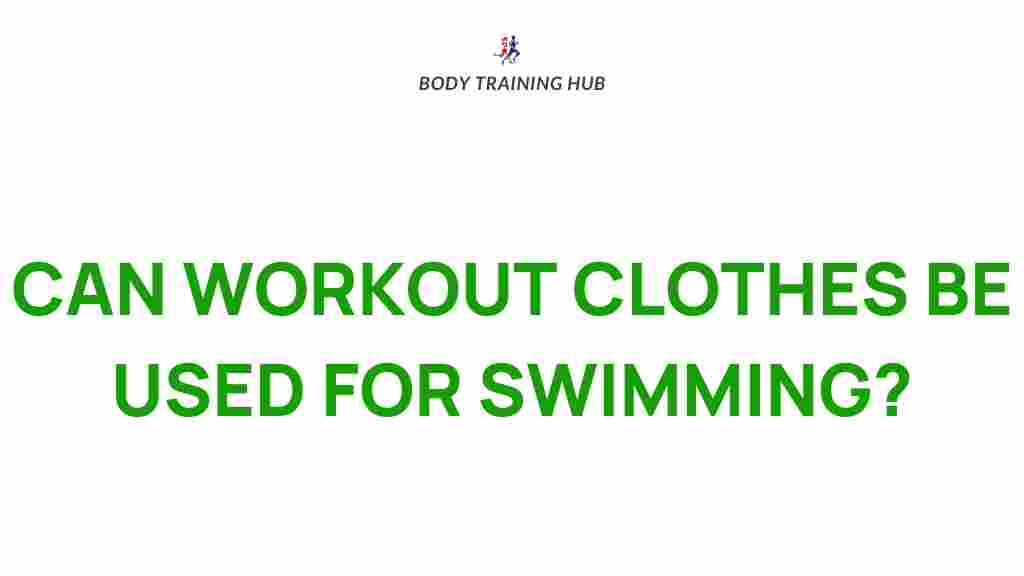Unveiling the Versatility of Workout Clothes
Workout clothes have evolved far beyond their initial purpose of serving as attire for exercise routines. In today’s world, fitness enthusiasts often look for multi-functional gear that can support their active lifestyles in and out of the gym. One question that arises is whether these garments can double up for swimming. Let’s dive deep into the practicality, benefits, and limitations of using workout clothes for swimming.
Understanding the Design and Fabric of Workout Clothes
To determine if workout clothes can be used for swimming, it’s essential to understand their material composition. Most workout apparel is made from fabrics like polyester, nylon, and spandex, which are known for their breathability, moisture-wicking properties, and stretchability. These characteristics make them suitable for intense workouts, but do they hold up in water?
While certain features of workout clothes align with swimwear, not all are designed for extended use in chlorinated pools or saltwater. Here’s what you need to consider:
- Durability in Water: Many workout clothes lack chlorine-resistant coatings, which can lead to fabric degradation over time.
- Compression Levels: Swimwear often provides streamlined compression for performance, while workout clothes may not.
- Design Differences: Swimwear is tailored for hydrodynamics, while workout clothes prioritize flexibility and comfort on land.
When Can Workout Clothes Be Used for Swimming?
Although not explicitly designed for aquatic activities, workout clothes can be a viable option in specific scenarios. These include:
- Recreational Swimming: For a casual dip in a pool or lake, workout clothes made of quick-drying material can work well.
- Water Workouts: Activities like aqua aerobics or paddleboarding may benefit from flexible workout gear.
- Emergency Situations: If swimwear is unavailable, workout clothes can temporarily suffice.
Before taking the plunge, check for labels indicating whether the fabric is water-resistant or has quick-drying capabilities.
Step-by-Step Guide: Using Workout Clothes for Swimming
If you plan to use workout clothes for swimming, follow these steps to ensure a comfortable experience:
- Choose Appropriate Fabric: Opt for clothes made from synthetic materials like polyester or nylon. These are more likely to dry quickly and retain shape in water.
- Check the Fit: Ensure a snug fit to avoid drag while swimming.
- Avoid Cotton: Cotton absorbs water and becomes heavy, making it unsuitable for swimming.
- Rinse Immediately: After swimming, rinse your workout clothes thoroughly to remove chlorine or salt, which can damage the fabric.
- Dry Properly: Allow the clothes to air-dry completely before their next use to maintain durability.
Benefits of Using Workout Clothes for Swimming
Using workout clothes for swimming can offer several advantages:
- Cost-Effectiveness: Eliminates the need to invest in separate swimwear for occasional use.
- Convenience: Saves packing space when traveling or heading to the gym.
- Versatility: Some designs are stylish enough to transition seamlessly between gym and pool.
For more insights on choosing multi-purpose fitness gear, check out our comprehensive guide to activewear.
Challenges and Limitations
While there are benefits, there are also challenges to consider:
- Fabric Wear: Prolonged exposure to chlorine or salt can weaken fabrics not designed for aquatic use.
- Lack of UV Protection: Unlike swimwear, workout clothes may not offer adequate sun protection for outdoor swimming.
- Reduced Performance: Without hydrodynamic features, workout clothes may hinder swimming speed and efficiency.
For detailed tips on maintaining your workout gear, explore this external guide.
Troubleshooting Tips for Using Workout Clothes in Water
If you encounter issues while swimming in workout clothes, here are some troubleshooting tips:
- Excessive Drag: Switch to tighter-fitting clothes or consider tying loose ends.
- Color Bleeding: Test the clothes in water before use to ensure dyes won’t bleed.
- Odor Retention: Soak clothes in a solution of water and vinegar after use to neutralize odors.
Conclusion
Workout clothes can be a versatile addition to your wardrobe, offering convenience and cost savings in certain swimming scenarios. While they may not replace traditional swimwear for competitive or regular swimming, they can be a practical option for recreational use or emergencies. By following the steps and tips outlined above, you can extend the utility of your workout gear without compromising its quality.
For more information on versatile fitness clothing, browse our latest articles on workout apparel. Stay active, stay stylish!
This article is in the category Strength & Recovery and created by BodyTraining Team
